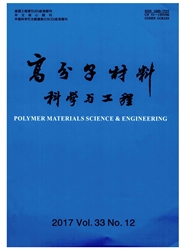

 中文摘要:
中文摘要:
我们使用了造纸厂污泥(下午) 代替过去常增强高密度聚乙烯(HDPE ) 的木头纤维(WF ) 的部分。产生 composites 受到捱过的氙弧。合成充满了有限下午(不到 10 ?%) 没有下午的类似于那些的有的机械性质和老化抵抗。没有下午,包含更多的下午的 composites 比那些更乐意地褪色并且裂开。基于羰基索引, crystallinity,和木头索引,下午看起来在捱过期间加速 composites 的降级。补充说到 WFHDPE composites 的下午减少了捱过的抵抗,并且如果 PMS 满足,这减小不是重要的没超过 20 ? 木头纤维的 % 。因此,下午能在层次在木头塑料 composites 被用作加强不到 20 ? 木头纤维内容的 % 。
 英文摘要:
英文摘要:
We used paper mill sludge(PMS) to substitute for part of the wood fibers(WF) used to reinforce high density polyethylene(HDPE).The resulting composites were subjected to xenon-arc weathering.The composite filled with limited PMS(under 10 %) had mechanical properties and aging resistance similar to those without PMS.The composites containing more PMS faded and cracked more readily than those without PMS.Based on the carbonyl index,crystallinity,and wood index,PMS appeared to accelerate the degradation of composites during weathering.Adding PMS to WF–HDPE composites reduced the weathering resistance,and this reduction was not significant if the PMS content did not exceed 20 % of the wood fibers.Therefore,PMS could be used as a reinforcement in wood-plastic composites at levels less than20 % of the wood fiber content.
 同期刊论文项目
同期刊论文项目
 同项目期刊论文
同项目期刊论文
 Effects of use of coupling agents on the properties of microfibrillar composite based on high-densit
Effects of use of coupling agents on the properties of microfibrillar composite based on high-densit Morphology, mechanical properties, and dimensional stability of wood fiber/HDPE composites: Effect o
Morphology, mechanical properties, and dimensional stability of wood fiber/HDPE composites: Effect o Effects of ionic liquid on therheological properties of wood flour/high density polyethylene composi
Effects of ionic liquid on therheological properties of wood flour/high density polyethylene composi Reliability analysis of timber structure design of poplar lumber with nondestructive testing methods
Reliability analysis of timber structure design of poplar lumber with nondestructive testing methods A wood replacement material of sandwich structure using coir fiber mats and fiberglass fabrics as co
A wood replacement material of sandwich structure using coir fiber mats and fiberglass fabrics as co High density polyethylene and poly(ethylene terephthalate) in situ sub-micro-fibril blends as a matr
High density polyethylene and poly(ethylene terephthalate) in situ sub-micro-fibril blends as a matr Mechanical and physical properties of core-shell structured wood plastic composites: Effect of shell
Mechanical and physical properties of core-shell structured wood plastic composites: Effect of shell Relativity analysis between dynamic and static modulus of elasticity on different thickness wood-pla
Relativity analysis between dynamic and static modulus of elasticity on different thickness wood-pla Effect of wood cell wall composition on the rheological properties of wood particle/high density pol
Effect of wood cell wall composition on the rheological properties of wood particle/high density pol Effect of Fiber Type and Coupling Treatment on Properties of High-Density Polyethylene/Natural Fiber
Effect of Fiber Type and Coupling Treatment on Properties of High-Density Polyethylene/Natural Fiber Mechanical properties evaluation of coir toughened unsaturated polyester with different reinforced b
Mechanical properties evaluation of coir toughened unsaturated polyester with different reinforced b Preparation of highly filled wood flour/recycled high density polyethylene composites by in situ rea
Preparation of highly filled wood flour/recycled high density polyethylene composites by in situ rea UV-initiated crosslinking of electrospun poly(ethylene oxide) nanofibers with pentaerythritol triacr
UV-initiated crosslinking of electrospun poly(ethylene oxide) nanofibers with pentaerythritol triacr Plasticizing cell walls as a strategy to produce wood-plastic composites with high wood content by e
Plasticizing cell walls as a strategy to produce wood-plastic composites with high wood content by e Effects of chemical modification with glutaraldehyde on the weathering performance of Scots pine sap
Effects of chemical modification with glutaraldehyde on the weathering performance of Scots pine sap Performance of bamboo plastic composites with hybrid bamboo and precipitated calcium carbonate fille
Performance of bamboo plastic composites with hybrid bamboo and precipitated calcium carbonate fille Experimental and numerical analysis of the sound insulation property of wood plastic composites (WPC
Experimental and numerical analysis of the sound insulation property of wood plastic composites (WPC Effect of zinc borate and wood flour on thermal degradation and fire retardancy of Polyvinyl chlorid
Effect of zinc borate and wood flour on thermal degradation and fire retardancy of Polyvinyl chlorid Grafting effects of polypropylene/polyethylene blends with maleic anhydride on the properties of the
Grafting effects of polypropylene/polyethylene blends with maleic anhydride on the properties of the Effects of hydrophobation treatments of wood particles with an amino alkylsiloxane co-oligomer on pr
Effects of hydrophobation treatments of wood particles with an amino alkylsiloxane co-oligomer on pr 期刊信息
期刊信息
